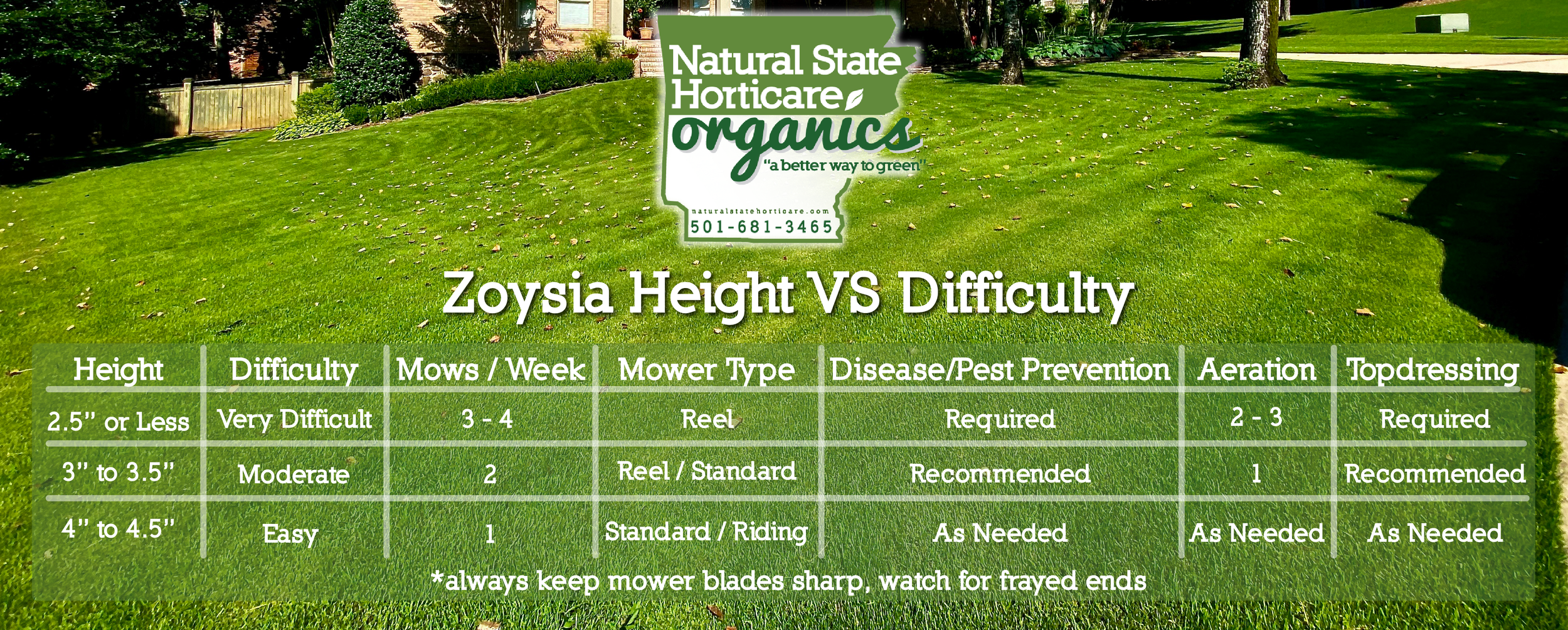Zoysia Grass
The Complete Guide to Caring for Zoysia Grass in Central Arkansas
Zoysia grass is one of the most popular lawn grasses in Central Arkansas, and for good reason. It’s known for its lush, dense growth, ability to handle heat and drought, and tolerance for moderate shade. While Zoysia is well-adapted to Arkansas’ challenging "transition zone" climate, it still requires specific care to thrive year-round.
This comprehensive guide covers everything you need to know about maintaining a beautiful Zoysia lawn in Central Arkansas, including mowing, watering, fertilizing, shade tolerance, pest control, disease prevention, and seasonal care.
Pros and Cons of Zoysia
Central Arkansas’ climate presents unique challenges for lawn care. Summers are hot and humid, while winters can bring periods of freezing temperatures. This makes lawn care more complex than in other regions.
Pros
✔ Excellent heat and drought tolerance—however, recovery from drought stress can be difficult.
✔ More cold-tolerant than Bermuda and St. Augustine.
✔ Dense growth helps it choke out weeds
✔ Moderate shade tolerance—better than Bermuda but less than St. Augustine.
✔ Soft texture
Cons
🚫 Slow to establish
🚫 Slow to spread
🚫 Slow to recover
🚫 Higher cost to install compared to Bermuda
🚫 Susceptible to fungal diseases
🚫 Can develop thatch buildup if not properly maintained
Zoysia Grass Varieties for Central Arkansas
✅ Meyer Zoysia (Recommended)
Fine to medium blade texture
Dense growth with good shade tolerance
Deep green color
Slower to establish but durable once rooted
✅ Zeon Zoysia
Fine-textured with a soft feel
Excellent drought tolerance
Best suited for residential lawns and golf courses
High disease resistance
✅ Emerald Zoysia (aka Shade King)
Dark green, fine-bladed grass
Tolerates partial shade better than other varieties
Low mowing height requirement
Slow-growing but forms a thick, carpet-like lawn
✅ Palisades Zoysia
Medium-textured blade
Fast growth and quick establishment
High drought and heat tolerance
Tolerates moderate shade
Mowing Advice
Proper mowing is essential for maintaining the health and appearance of Zoysia grass.
Recommended Mowing Height:
2.5 – 4 inches for most varieties
See the charts below to determine what height is right for you.
Frequency:
Mow every 5–7 days during peak growing season (late spring to early fall).
You can mow less frequently in early spring and late fall as growth slows.
Never cut more than ⅓ of the blade height at once to prevent stress.
Best Practices:
✅ Keep mower blades sharp to ensure clean cuts.
Click here to watch a helpful how-to video about sharpening your mower blades.
✅ Avoid mowing when the grass is wet to prevent tearing and disease spread.
✅ Allow Zoysia to grow slightly taller in shaded areas to maximize photosynthesis.
✅ Leave clippings on the lawn unless there’s excessive thatch buildup.
Watering Advice
Zoysia is more drought-tolerant than St. Augustine but less drought-tolerant than Bermuda. Once established, Zoysia can survive dry spells, but consistent watering helps maintain its color and density.
How Much Water:
Zoysia needs 1 – 1.5 inches of water per week, including rainfall.
Increase to 2 inches per week during prolonged drought or extreme heat.
Water deeply and infrequently rather than lightly and often to promote deep roots.
Best Time to Water:
Water early in the morning (before 10 a.m.) to reduce evaporation.
Avoid watering in the evening to prevent fungal growth.
Signs of Under-watering:
Grass turns bluish-gray instead of green before turning brown. (shadowing)
Grass blades curl and wilt.
Signs of Overwatering:
Mushy ground or standing water.
Increased weed and fungus activity.
Grass starts thinning and turning yellow / orange.
Shade Tolerance of Zoysia Grass
Zoysia offers moderate shade tolerance but still needs at least 4–5 hours of direct sunlight per day to thrive. Click here to learn more about shade issues.
Thrives In:
✔ Full Sun
✔ Partially shaded areas (mostly full sun)
Struggles In:
🚫 Dense shade under tree canopies or next to buildings, fences, etc.
🚫 Areas with less than 4 hours of sunlight per day
💡 Tip: Raising the mowing height in shaded areas can help Zoysia capture more light and improve its ability to grow.
Disease & Pest Control for Zoysia Grass
Zoysia is more disease-resistant than St. Augustine but can still be affected by certain diseases and pests. Click here to learn more about common lawn pests.
Common Diseases:
Large Patch – Occurs in warm, humid weather; treat with fungicides.
Dollar Spot – Creates small, brown patches; improve nitrogen levels and treat with fungicides.
Rust – Appears as an orange powder on grass blades; improve air circulation and reduce watering frequency.
Common Pests:
Grubs – Feed on roots, causing wilting and patchy thinning.
Spittlebugs – Sucks the chlorophyll, nutrients, and moisture out of blades; treat with insecticides.
Armyworms – Cause rapid thinning; treat immediately with insecticides.
💡 Tip: A strong, well-maintained lawn is the best defense against pests and diseases.
Winter Dormancy and Cold Tolerance
Zoysia grass will go dormant in the winter, turning brown as temperatures drop below 50°F.
Winter Care:
✅ Lower grass to 2.5 inches before dormancy to prevent rot and/or matting.
✅ Avoid heavy foot traffic on dormant Zoysia to prevent damage.
✅ Remove leaves and debris to avoid moisture buildup and fungal growth.


